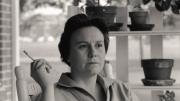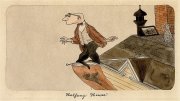Casey N. Cep ’07, a former Berta Greenwald Ledecky Undergraduate Fellow at this magazine, has since written widely and well, for The New Yorker, The New York Times, and other publications. But she has never written anything like Furious Hours: Murder, Fraud, and the Last Trial of Harper Lee (Knopf, $26.95), her first book, on the dual mysteries of a notorious crime and a famous novelist’s attempt to write about it. The gripping pace is established in the prologue.
…Hundreds of people were crowded into the gallery, filling the wooden benches that squeaked whenever someone moved or leaning against the back wall if they hadn’t arrived in time for a seat. Late September was not late enough for the Alabama heat to have died down, and the air-conditioning in the courtroom wasn’t working, so the women waved fans while the men’s suits grew damp under their arms and around their collars. The spectators whispered from time to time, and every so often they laughed—an uneasy laughter that evaporated whenever the judge quieted them.
The defendant was black, but the lawyers were white, and so were the judge and jury. The charge was murder in the first degree. Three months before, at the funeral of a 16-year-old girl, the man with his legs crossed patiently beside the defense table had pulled a pistol from the inside pocket of his jacket and shot the Reverend Willie Maxwell three times in the head. Three hundred people had seen him do it. Many of them were now at his trial, not to learn why he had killed the Reverend—everyone in three counties knew that, and some were surprised no one had done it sooner—but to understand the disturbing series of deaths that had come before the one they’d witnessed.
One by one, over a period of seven years, six people close to the Reverend had died under circumstances that nearly everyone agreed were suspicious and some deemed supernatural. Through all of the resulting investigations, the Reverend was represented by a lawyer named Tom Radney, whose presence in the courtroom that day wouldn’t have been remarkable had he not been there to defend the man who killed his former client. A Kennedy liberal in the Wallace South, Radney was used to making headlines, and this time he would make them far beyond the local Alexander City Outlook. Reporters…had flocked to Alexander City to cover what was already being called the tale of the murderous voodoo preacher and the vigilante who shot him.
One of the reporters, though, wasn’t constrained by a daily deadline. Harper Lee lived in Manhattan but still spent some of each year in Monroeville…only 150 miles away from Alex City. Seventeen years had passed since she’d published To Kill a Mockingbird and 12 since she’d finished helping her friend Truman Capote report the crime story in Kansas that became In Cold Blood. Now, finally, she was ready to try again.…She would spend a year in town investigating the case, and many more turning it into prose. The mystery in the courtroom that day was what would become of the man who shot the Reverend Willie Maxwell. But for decades after the verdict, the mystery was what became of Harper Lee’s book.









